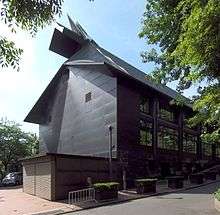Association of Shinto Shrines

The Association of Shinto Shrines (神社本庁 Jinja Honchō) is a religious administrative organisation that oversees about 80,000 Shinto shrines in Japan. These shrines take the Ise Grand Shrine as the foundation of their belief.
The Association has five major activities:
- Publication and dissemination of information on shrine Shinto
- Performance of rituals
- Education of adherents of Shinto
- Reverence of the Ise Shrine and distribution of its amulets
- Preparation for the Shinto priesthood
It also performs other related activities.
The Association was established following the end of World War II, the Surrender of Japan. On 15 December 1945, the Supreme Commander for the Allied Powers (SCAP) issued the Shinto Directive ordering the separation of Shinto from the State. On February 2, 1946, to comply with the SCAP order, three organizations, the Kōten Kōkyūjo (皇典講究所), Dainippon Jingikai (大日本神祇会), and Jingū Hōsaikai (神宮奉斎会), established the nongovernmental Association, assuming the functions of the Jingi-in, a branch of the Home Ministry.
The Association of Shinto Shrines has an administrative structure including a main office and branches. Its headquarters in Yoyogi, Shibuya, Tokyo, adjacent to the Meiji Shrine. Its leadership includes the Sosai (総裁), the head priestess of the Ise Shrine, presently Atsuko Ikeda. The tōri (統理) is Kuniaki Kuni, and the post of sōchō (総長) or Secretary-General is currently held by Masami Yatabe, the chief priest of the Mishima Shrine. The Association maintains regional offices in every prefecture. They handle financial and personnel matters for member shrines.
The Association has many contacts within the Liberal Democratic Party and is a successful lobbyist; its influence can be seen in recent conservative legislation, like the legal recognition of the National Flag (Hinomaru) and National Anthem (Kimigayo), their use for official school events, or the revision of Fundamental Education Law, and it is behind some actions by conservative politicians, like visits to Yasukuni Shrine by Junichirō Koizumi, the Prime Minister of Japan. [1]
References
Sources
This article incorporates material in 神社本庁 (Jinja Honchō) in the Japanese Wikipedia, retrieved on January 27, 2008.